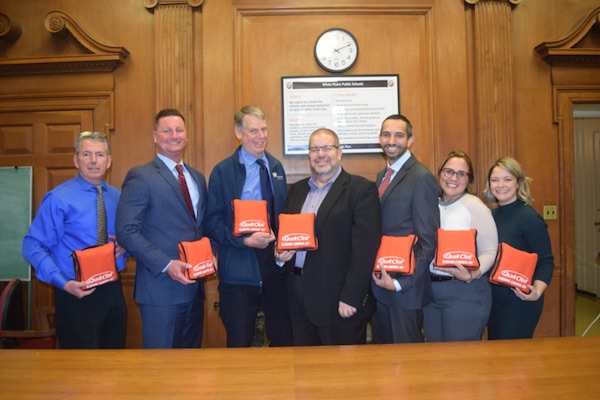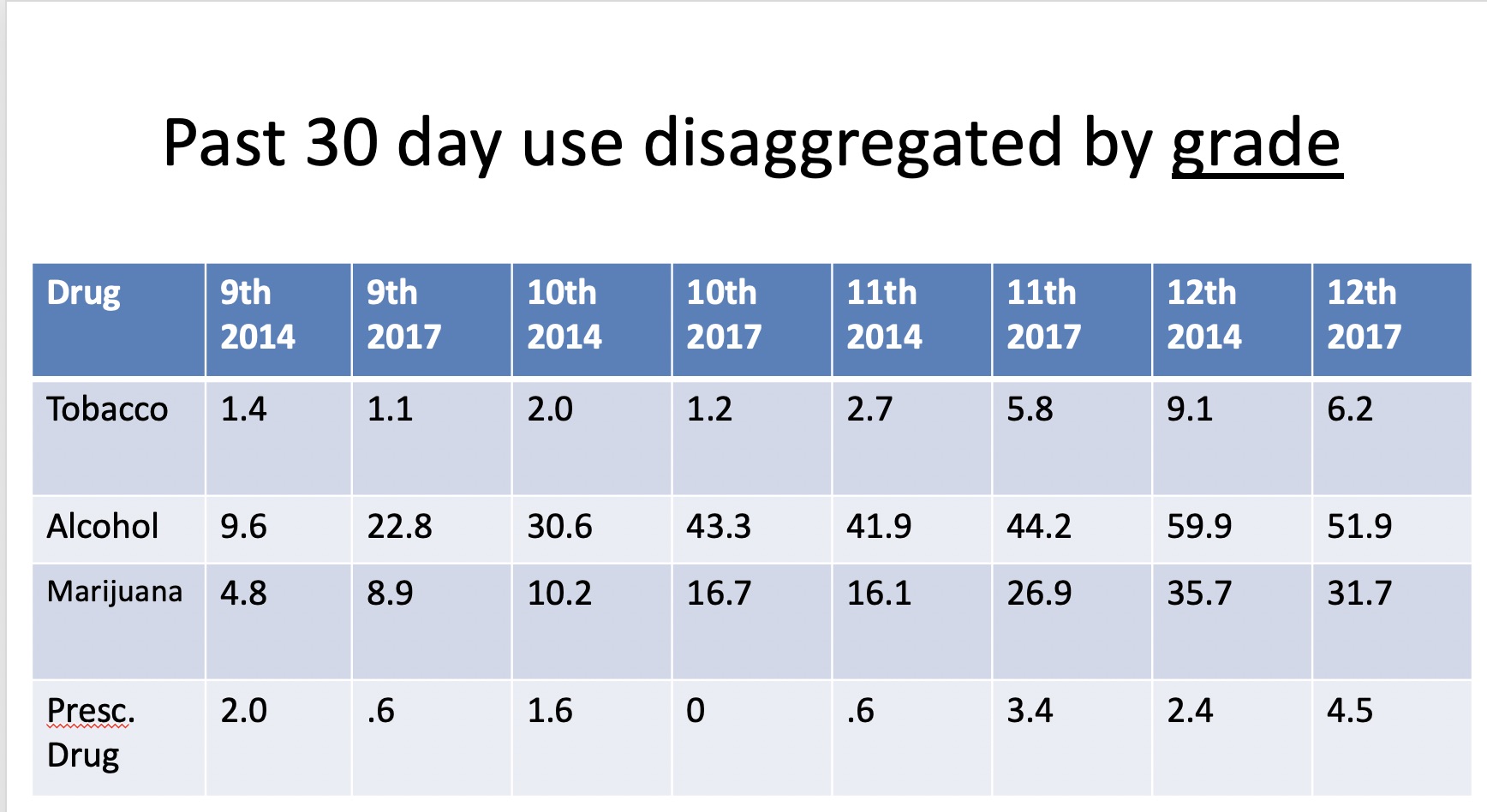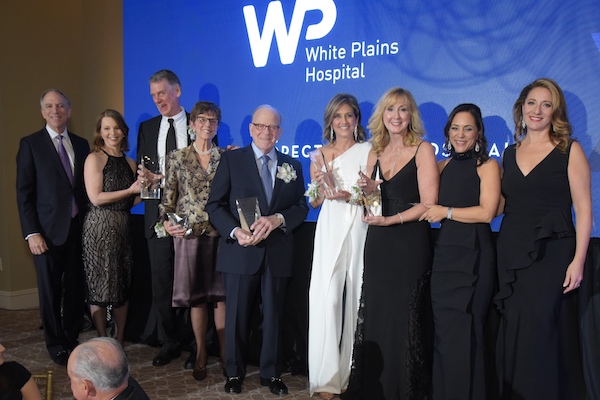White Plains Hospital Provides ‘Stop the Bleed’ Kits to White Plains School District
- Details
- Written by Joanne Wallenstein
- Category: Health
 As a follow up to Stop the Bleed training provided to White Plains School District teachers, staff, and administrators in 2019, White Plains Hospital recently donated Stop the Bleed kits to the White Plains School District. The kits will be available in White Plains schools throughout the district and will be placed near defibrillator units already commonly available in schools. Stop the Bleed kits include tourniquets and wound packing equipment, and are designed to help save lives in the event of a bleeding emergency. Recognizing this as the next level of school emergency preparedness, White Plains Hospital and the White Plains School District have teamed up to provide ongoing Stop the Bleed training to its staff through simulations using high fidelity mannequins.
As a follow up to Stop the Bleed training provided to White Plains School District teachers, staff, and administrators in 2019, White Plains Hospital recently donated Stop the Bleed kits to the White Plains School District. The kits will be available in White Plains schools throughout the district and will be placed near defibrillator units already commonly available in schools. Stop the Bleed kits include tourniquets and wound packing equipment, and are designed to help save lives in the event of a bleeding emergency. Recognizing this as the next level of school emergency preparedness, White Plains Hospital and the White Plains School District have teamed up to provide ongoing Stop the Bleed training to its staff through simulations using high fidelity mannequins.
(Pictured at top left to right) Sean Lews, WP School District Security; Joseph Ricca, WP School District Superintendent; Dr. Erik Larsen, Assistant Director of EMS & Emergency Preparedness at WPH; Ed Tangredi, Director of Emergency Management at WPH; Dr. Farrukh Jafri, Assistant Director of Education and Simulation Emergency Department; Maggie Racioppo, Nurse Coordinator at WP School District; Kate Lopez, Senior Director of Marketing at WPH.
A Guide to Intermittent Fasting
- Details
- Written by Joanne Wallenstein
- Category: Health
 This health article was sponsored by White Plains Hospital
This health article was sponsored by White Plains Hospital
Are you a breakfast-skipper, or a late-night snacker? Intermittent fasting might be the perfect weight loss plan for you.
Starting a diet that requires you to make drastic changes or big sacrifices to foods you love is usually a waste of time. People can’t stick to those types of diets over time. The most successful weight loss programs work with your lifestyle, not against it, which is why many people are intrigued by the idea of intermittent fasting. Intermittent fasting is not a diet per se, but a change in the way you eat. Here are the details to help decide if it is right for you.
How does intermittent fasting work?
When you go a long time without eating, your body needs to start burning fat as fuel. Intermittent fasting increases the metabolic rate (calories out) and restricts the food you eat (calories in) – a win-win for weight loss. Say someone was picking up a bagel on their way to work, and snacking too much late in the evening. On an intermittent fasting schedule of 11 a.m. to 7 p.m., the morning bagel is skipped and there’s no opportunity for that late-night piece of pie. Of course you are going to lose weight!
Another benefit is that by not eating, especially carbohydrates, the body is not signaling insulin. Insulin is a hormone that helps the body’s cells open up and store excess food and fat to use as energy later. In overeaters, insulin must work overtime to keep up with the continuous conveyer belt of food, eventually burning out and not working as well. The result is too much sugar left circulating in the bloodstream, which is unhealthy for the heart.
How many hours do you need to go without eating?
Twelve hours is the minimum timespan for successful intermittent fasting. This is the best way to start out. So, if you have breakfast at 8 a.m., do not eat anything after 8 p.m. This will leave your stomach empty from bedtime till the next morning. The next phase would be to try to eat all your daily meals within a 10-hour, and eventually within an 8-hour span – the strictest, and maximum level. Many people stick to 11 a.m. to 7 p.m. or 12 p.m. to 8 p.m.
In the morning, it is okay to wait to eat until you feel real physical hunger kicking in. Instead of waking up and eating right away, see what time your body starts asking for your first meal (meaning your belly is growling from hunger versus you just thinking about food).
Who should try intermittent fasting… and who should not?
Those who usually eat high-carb, less healthy breakfasts (bagels, French toast, pancakes, cold breakfast cereal, those who aren’t hungry when they wake up, or late-night snackers may do well on this eating plan. Also, some people feel it is overwhelming to make too many food decisions during the day. Since intermittent fasting often involves two meals and one afternoon snack, they have fewer decisions to make and less contact with food during the day, so this plan may make sense for them.
Who should not try it?
Those taking blood-sugar management medication for diabetes should be careful with IF. Also, anyone who needs to take medication with food. People who are prone to migraines or headaches when they go too long without eating should avoid intermittent fasting.
What if you have a special event that throws off your schedule?  Going outside your normal window from time to time doesn’t need to doom to your wellness and weight management goals. Scheduled a morning workout? Just eat a healthy breakfast of two eggs, or Greek yogurt with berries, or a 100-calorie portion of oatmeal with 1 Tbs. almond butter mixed in. (You can drink water or coffee or tea, ideally black or using unsweetened almond milk anytime during intermittent fasting.)
Going outside your normal window from time to time doesn’t need to doom to your wellness and weight management goals. Scheduled a morning workout? Just eat a healthy breakfast of two eggs, or Greek yogurt with berries, or a 100-calorie portion of oatmeal with 1 Tbs. almond butter mixed in. (You can drink water or coffee or tea, ideally black or using unsweetened almond milk anytime during intermittent fasting.)
Just remember that what you eat during that meal window DOES matter. I have seen people try intermittent fasting thinking they can eat anything they want, and they do not lose weight. Intermittent fasting is a way to help you to make healthy eating choices, within boundaries.
Elizabeth DeRobertis, MS, RD, CDN, CDE, is a registered dietitian and nutritionist. To make an appointment, call the Scarsdale Medical Group at (914) 723-8100.
What to Eat When You Have a Cold: Power-Packed Foods to Make You Feel Better Faster
- Details
- Written by Diane May
- Category: Health
 This article is written by Diane May, a nutritionist at White Plains Hospital.
This article is written by Diane May, a nutritionist at White Plains Hospital.
With the cold and flu season upon us, there are other protective measures we can take beyond just regularly washing our hands. Food is powerful medicine that can kick our immune systems into gear, both to fend off viruses as well as reduce the severity and duration of symptoms such as congestion, sore throat and fatigue.
I often prescribe these essentials as part of any cold-sufferer’s diet:
Garlic
Garlic has been studied for centuries for its anti-bacterial properties. When garlic is sliced, chewed or crushed, sulfur compounds such allicin, diallyl disulfide, vinyldithiins and s-allyl cycteine are activated (giving off that distinctive garlic smell). These have been shown to support the disease-fighting response of some types of white blood cells, helping them to fight viruses. Garlic can also be taken as a preventative supplement: I recommend 300 mg a day, or incorporating one to two fresh cloves daily into your diet, including in salad dressings, green juices, or simply rubbing it on whole grain bread for delicious flavored toast.
Chicken Soup
Good, old fashioned chicken soup has been used forever as a common cold aide and there are some real benefits. The warm broth can help alleviate congestion and the electrolytes (sodium) found in the broth can help keep you hydrated and soothe a sore throat. The added chicken and vegetables provide additional protein and nutrients, with carrots, celery, onion, turnip and fresh herbs supplying an even bigger nutritional boost.
Tea
When you aren’t feeling your best, warm fluids can soothe that scratchy throat and help to loosen mucus. Opt for decaffeinated tea as caffeine is dehydrating, which is the last thing you need when you are trying to flush a virus from your system. I always recommend ginger tea, as it can soothe a stomach that’s upset from loose mucus draining into the digestive system. Ginger also has anti-inflammatory properties that assist with immune function.
Non-Fat Greek Yogurt
Loaded with live cultures and probiotics, yogurt helps to keep your gut lining healthy. Approximately 70% of our immune system is located in our gut, so it is important to keep it in good fighting shape in case your body encounters a virus. Consuming probiotic rich foods can lower the risk of catching a cold and help to speed recovery if you have caught one. Another perk, non-fat Greek yogurt has triple the protein of regular yogurt (without the added sugar).
Red Bell Peppers
Vitamin C is essential for the function of immune cells, and during infections our bodies quickly become deficient of this vitamin. Eating foods rich in vitamin C during a cold or virus can speed the body’s recovery and reduce symptoms. Since vitamin C is water soluble, it’s more efficient to consume it through foods high in vitamin C, such as red bell peppers, rather than from solid supplements which require more work for the body to digest and absorb. One cup of chopped red bell pepper contains 190 mg of this important vitamin. Other foods high in vitamin C include kiwifruit, broccoli, dark leafy greens and citrus fruits.
Blueberries
Blueberries are a great source of anthocyanins, a type of flavonoid that gives the berry (and other colorful fruits and vegetables) it’s rich, deep color. Flavinoids have anti-inflammatory, anti-bacterial and antioxidant properties that can help reduce cell damage and boost immune function. A powerhouse berry that’s low in calories, you can snack on them, add to salads or treat yourself to a crumble.
Diane May, MPH, MS, CDN, RD, CSOWM is a registered dietitian with Scarsdale Medical Group. To make an appointment, call (914) 723-8100.
Panelists Warn Parents of the Danger of Hosting Teen Parties at Home
- Details
- Written by Wendy MacMillan
- Category: Health
 Pride Survey of Drug and Alcohol Usage 2017As parents we do everything we can to guarantee our children’s safety. To protect toddlers we covered the electric outlets. When our kids learn to ride a bike, we outfit them with knee pads and helmets. When they’re ready to venture out on their own we warn them about the danger of speaking to strangers. But how can we safeguard teens when they attend parties and experiment with drugs and alcohol?
Pride Survey of Drug and Alcohol Usage 2017As parents we do everything we can to guarantee our children’s safety. To protect toddlers we covered the electric outlets. When our kids learn to ride a bike, we outfit them with knee pads and helmets. When they’re ready to venture out on their own we warn them about the danger of speaking to strangers. But how can we safeguard teens when they attend parties and experiment with drugs and alcohol?
It’s a conundrum. Do we forbid them from taking a sip or wine or beer or accept the fact that at some point they will indulge? I’ve heard some parents reason that experimentation is inevitable and say, “It’s better if my teen and their friends drink in my home, that way I know they are safe.” Well if that’s your line of thinking, the Scarsdale Drug and Alcohol Task Force (DATF) and our local police department would ask you to think twice before letting this happen.
On Wednesday 12/11, DATF presented a Social Hosting Panel Discussion with panelists: Susan Brownbill-Vega, Assistant District Attorney, Westchester County, Chief Andrew Matturro, Scarsdale Police Department, Detective Jason Bronstein, Community Resource Officer - Scarsdale Police Department, Dr. James Bregman, ER Physician - White Plains Hospital, and moderated by Emily Vallario, LCSW, Director of Community Services, Scarsdale Edgemont Family Counseling Services.
Ms. Vallario began the discussion by providing statistics from the most recent Pride Survey on substance usage among Scarsdale students in 2017. The Pride Survey is a bi-annual study that surveys high school students about their substance use and their perceptions about perceived rates of substance use. The survey revealed that 40% of all students and 52% of all seniors, admitted to using alcohol in the last 30 days. The survey also revealed that 57% of students who admitted to drinking, said they got the alcohol from their home or from a friend’s home.
So what do these stats mean for parents? Well quite a lot, but the group of panelists thought we should all be aware that Westchester County has a law in place called the Social Host Law aimed at reducing underage drinking. Moreover, as Assistant D.A. Brownbill-Vega explained, the ordinance came into effect in 2008 and allows for local police to take action at parties and get involved when things may get out of hand. Brownbill-Vega also proclaimed that the ordinance is in place to encourage adults to act responsibly and to keep our children safe from unwanted consequences of under-age drinking. A quick look at the Westchester County D.A. website defines the law this way:
Under the Westchester County ‘Social Host Law,’ it is unlawful for any person over the age of 21 to “knowingly allow” or “to fail to take reasonable corrective action upon becoming aware of” the consumption of alcohol by minors in his or her residence. The social host law “[serves] to deter the consumption of alcoholic beverages by minors by holding those persons who are 21 years old or more responsible.”
Under the New York State Penal Law, any person who gives, sells or causes to be given or sold any alcoholic beverage to someone under the age of 21 faces potential prosecution for Unlawfully Dealing with a Child, a class “A” misdemeanor, which could result in up to one year in jail and/or a fine.
Ms. Vallario continued the discussion with a question for Chief Andrew Matturro. She asked, “Empowered by the Social Host Law, how does our local police department usually respond when they are dispatched to a house party?” Chief Matturro stated that the Scarsdale PD works very closely with Scarsdale Edgemont Family Counseling Services to try to prevent things before they happen. From educating students in school, to presenting information to parents at events like this one, Chief Matturro stressed that it is about safety first. This includes keeping kids safe from the consequences of underage drinking such as vandalism, sexual assault, and accidents. Chief Matturro went on to detail the 911 Good Samaritan Law which allows people to call 911 without fear of arrest if they are having a drug or alcohol overdose that requires emergency medical care or if they witness someone overdosing.
Detective Bronstein, Community Resource Officer, also stressed the police department’s focus on safety when they respond to calls about parties. He stated that when they are called to a party (usually due to a noise complaint or too many guests), police officers first work to make sure that everyone is safe, that no one is sick or putting themselves in danger. They also try to locate an adult to speak to and if there are no adults present, they will search for the teen who lives in the home. Police officers then contact each party goer’s parents to ensure that everyone leaves with an adult.
Detective Bronstein further explained that in addition to being given a summons if it is proven that adults knowingly let teens drink in their home, those same adults can be held accountable through civil lawsuits if an intoxicated teen leaves the home and causes damage elsewhere. Other penalties after being found guilty depend on the circumstances and how often one has broken the Social Host law. Though the penalties are not usually severe, first time offenders can be fined $250 and repeat offenders can be fined up to $1,000 and sentenced to jail time.
Both officers said that as soon as you suspect or are notified of teens drinking alcohol in your home, you should take constructive actions to stop the activity. Likewise, if teens arrive at your home intoxicated but have not consumed alcohol at your residence, you should still take constructive action or you can be found liable for drinking related consequences the teen may suffer under your supervision. They also encourage parents to call the police department for help if a party is “getting out of hand” in any way.
Furthermore, while police officers must be invited into your home or have warrants to gain full access, if they have any reason to believe the situation is dangerous or anyone is in danger, they will enter the premise. Again, the police’s main goal is to keep all Scarsdale residents safe and protected. Chief Matturro emphasized that while they certainly do not condone any sort of underage drinking, they are not looking to punish but instead want to work with parents and the community to be part of a solution. And to answer an audience member’s question, it is in the spirit of solution based thinking that officers won’t usually force teens at parties to show ID. They do however, strongly urge all community members to cooperate with the police at all times as it usually works out best for everyone involved.
Adding to this informative discussion was panelist Dr. James Bregman who is an ER Physician at White Plains Hospital. Dr. Bregman began by describing some of the situations in relation to underage drinking he encounters. He has helped teens in a variety of situations, from an over-worried parent bringing in their slightly intoxicated teen, to extreme intoxication/alcohol poisoning needing more serious care such as an I.V. drips and overnight monitoring. In regard to alcohol poisoning, Dr. Bregman wants kids to know that alcohol and other drugs, can affect everyone differently depending on their body mass, tolerance level, metabolism, genetics, grade of alcohol, and more. He also worries that many young people binge drink, leading to a higher alcohol content in their blood which in turn can lead to alcohol poisoning. Dr. Bregman reminded us that severe intoxication can greatly affect the central nervous system and impact balance, coordination, and judgement leading to risk of physical injury. Severe intoxication can also lead to loss of unconscious and risk of aspiration. When asked if he saw more vaping related ER visits, Dr. Bregman said that they were certainly on the rise but that alcohol consumption was still the leading reason for a trip to the ER.
The presentation neatly concluded when one parent suggested that we need more spaces for our teens to hang out at and another parent asked, “What can we do as parents? Tell our children to never drink or be more realistic and prepare for the times that they might experiment?” All of the panelists seemed to agree that it is important to talk to your kids. Have open, honest conversations with your children about the risks and consequences of drinking starting at an early age. Ms. Brownbill-Vega suggests that we make it very clear what our expectations are as parents and what we expect of our children. Chief Matturro also suggests that we use our community resources such as the police department and DATF. Lastly Emily Vallario reminded us that it really does take a village. She explained that SEFCS and the police department work closely with both the middle and high school to give presentations to educate students and to provide parent groups and educational presentations to the community.
For more information click here.
Friends of White Plains Hospital Raise $1.4 Million at Gala
- Details
- Written by Joanne Wallenstein
- Category: Health
 Laurence Smith (Chairman of WPH Board of Directors) of Scarsdale, Susan Fox (CEO & President), Dr. Erik Larsen, Lucy Schmolka, Allen Waxenberg, Wendy Berk, Kathy Winterroll of Scarsdale, Geralyn Della Cava of Scarsdale, Anna Cappucci.The Friends of White Plains Hospital hosted the “Best is Yet to Come” BASH of White Plains Hospital on Saturday, November 16th. The sold-out evening at Brae Burn Country Club raised $1.4 million for the Hospital’s new Center for Advanced Medicine & Surgery. The gala was co-chaired by Wendy Berk, of Scarsdale; Anna Cappucci, of Harrison; and Geralyn Della Cava and Kathleen Winterroll, both of Scarsdale. Over 600 guests gathered to celebrate the Hospital and honor five exceptional volunteers, and enjoyed a night of dinner, dancing, and a silent auction.
Laurence Smith (Chairman of WPH Board of Directors) of Scarsdale, Susan Fox (CEO & President), Dr. Erik Larsen, Lucy Schmolka, Allen Waxenberg, Wendy Berk, Kathy Winterroll of Scarsdale, Geralyn Della Cava of Scarsdale, Anna Cappucci.The Friends of White Plains Hospital hosted the “Best is Yet to Come” BASH of White Plains Hospital on Saturday, November 16th. The sold-out evening at Brae Burn Country Club raised $1.4 million for the Hospital’s new Center for Advanced Medicine & Surgery. The gala was co-chaired by Wendy Berk, of Scarsdale; Anna Cappucci, of Harrison; and Geralyn Della Cava and Kathleen Winterroll, both of Scarsdale. Over 600 guests gathered to celebrate the Hospital and honor five exceptional volunteers, and enjoyed a night of dinner, dancing, and a silent auction. Linda Plattus, Howard Berk, Wendy Berk, Carrie Bank, Andy Bank, Michael Meyers, and Eileen Meyers
Linda Plattus, Howard Berk, Wendy Berk, Carrie Bank, Andy Bank, Michael Meyers, and Eileen Meyers Allison Fehrenbaker, Patti Dweck, Wendy Kleinman, Amy Hirschhorn, Joan and Joel Picket
Allison Fehrenbaker, Patti Dweck, Wendy Kleinman, Amy Hirschhorn, Joan and Joel Picket Ralph and Geralyn Della Cava and Kathleen and Christopher Winterroll
Ralph and Geralyn Della Cava and Kathleen and Christopher Winterroll














